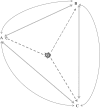What scatter-hoarding animals have taught us about small-scale navigation
- PMID: 20156815
- PMCID: PMC2830246
- DOI: 10.1098/rstb.2009.0214
What scatter-hoarding animals have taught us about small-scale navigation
Abstract
Many animals use cues for small-scale navigation, including beacons, landmarks, compasses and geometric properties. Scatter-hoarding animals are a unique system to study small-scale navigation. They have to remember and relocate many individual spatial locations, be fairly accurate in their searching and have to remember these locations for long stretches of time. In this article, we review what is known about cue use in both scatter-hoarding birds and rodents. We discuss the importance of local versus global cues, the encoding of bearings and geometric rules, the use of external compasses such as the Sun and the influence of the shape of experimental enclosures in relocating caches or hidden food. Scatter-hoarding animals are highly flexible in how and what they encode. There also appear to be differences in what scatter-hoarding birds and rodents encode, as well as what scatter-hoarding animals in general encode compared with other animals. Areas for future research with scatter-hoarding animals are discussed in light of what is currently known.
Figures




Similar articles
-
Using ecology to guide the study of cognitive and neural mechanisms of different aspects of spatial memory in food-hoarding animals.Philos Trans R Soc Lond B Biol Sci. 2010 Mar 27;365(1542):883-900. doi: 10.1098/rstb.2009.0211. Philos Trans R Soc Lond B Biol Sci. 2010. PMID: 20156814 Free PMC article. Review.
-
The history of scatter hoarding studies.Philos Trans R Soc Lond B Biol Sci. 2010 Mar 27;365(1542):869-81. doi: 10.1098/rstb.2009.0217. Philos Trans R Soc Lond B Biol Sci. 2010. PMID: 20156813 Free PMC article. Review.
-
Determinants of seed removal distance by scatter-hoarding rodents in deciduous forests.Ecology. 2007 Oct;88(10):2529-40. doi: 10.1890/07-0247.1. Ecology. 2007. PMID: 18027756
-
Olfaction alters spatial memory strategy of scatter-hoarding animals.Integr Zool. 2021 Jan;16(1):128-135. doi: 10.1111/1749-4877.12498. Epub 2020 Nov 22. Integr Zool. 2021. PMID: 33136309
-
Memory and the hippocampus in food-storing birds: a comparative approach.Neuropharmacology. 1998 Apr-May;37(4-5):441-52. doi: 10.1016/s0028-3908(98)00037-9. Neuropharmacology. 1998. PMID: 9704985 Review.
Cited by
-
Sex differences in the use of spatial cues in two avian brood parasites.Anim Cogn. 2021 Jan;24(1):205-212. doi: 10.1007/s10071-020-01434-8. Epub 2020 Sep 27. Anim Cogn. 2021. PMID: 32980971
-
Flower bats (Glossophaga soricina) and fruit bats (Carollia perspicillata) rely on spatial cues over shapes and scents when relocating food.PLoS One. 2010 May 25;5(5):e10808. doi: 10.1371/journal.pone.0010808. PLoS One. 2010. PMID: 20520841 Free PMC article.
-
Taking an insect-inspired approach to bird navigation.Learn Behav. 2018 Mar;46(1):7-22. doi: 10.3758/s13420-018-0314-5. Learn Behav. 2018. PMID: 29484541 Free PMC article. Review.
-
Integrating ecology, psychology and neurobiology within a food-hoarding paradigm.Philos Trans R Soc Lond B Biol Sci. 2010 Mar 27;365(1542):859-67. doi: 10.1098/rstb.2009.0216. Philos Trans R Soc Lond B Biol Sci. 2010. PMID: 20156812 Free PMC article.
-
Motion, identity and the bias toward agency.Front Hum Neurosci. 2014 Aug 21;8:597. doi: 10.3389/fnhum.2014.00597. eCollection 2014. Front Hum Neurosci. 2014. PMID: 25191245 Free PMC article.
References
-
- Balda R. P.1980Recovery of cached seeds by captive Nucifraga caryocatactes. Z. Tierpsychol. Beih. 52, 331–346
-
- Balda R. P., Kamil A. C.1989A comparative study of cache recovery by three corvid species. Anim. Behav. 38, 486–495 (doi:10.1016/S0003-3472(89)80041-7) - DOI
-
- Barkley C. L., Jacobs L. F.1998Visual environment and delay affect cache retrieval accuracy in a food-storing rodent. Anim. Learn. Behav. 26, 439–447
-
- Batty E. R., Bloomfield L. L., Spetch M. L., Sturdy C. B.2009Comparing black-capped (Poecile atricapillus) and mountain chickadees (Poecile gambeli): use of geometric and featural information in a spatial orientation task. Anim. Cognit. 12, 633–641 (doi:10.1007/s10071-009-0222-3) - DOI - PubMed
-
- Bennett A. T. D.1993Spatial memory in a food storing corvid. 1. Near tall landmarks are primarily used. J. Comp. Physiol. Sensory Neural Behav. Physiol. 173, 193–207
Publication types
MeSH terms
LinkOut - more resources
Full Text Sources

